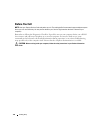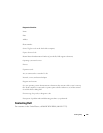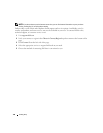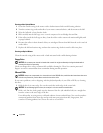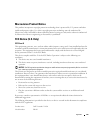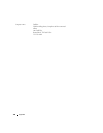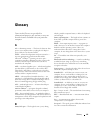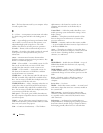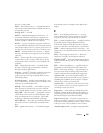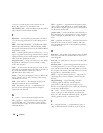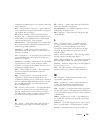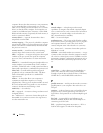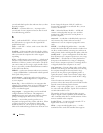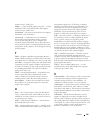
142 Glossary
byte — The basic data unit used by your computer. A byte
is usually equal to 8 bits.
C
C — Celsius — A temperature measurement scale where
0° is the freezing point and 100° is the boiling point of
water.
cache — A special high-speed storage mechanism which
can be either a reserved section of main memory or an
independent high-speed storage device. The cache
enhances the efficiency of many processor operations.
L1 cache — Primary cache stored inside the processor.
L2 cache — Secondary cache which can either be external
to the processor or incorporated into the processor
architecture.
carnet — An international customs document that
facilitates temporary imports into foreign countries. Also
known as a merchandise passport.
CD-R — CD recordable — A recordable version of a CD.
Data can be recorded only once onto a CD-R. Once
recorded, the data cannot be erased or written over.
CD-RW — CD rewritable — A rewritable version of a
CD. Data can be written to a CD-RW disc, and then
erased and written over (rewritten).
CD-RW drive — A drive that can read CDs and write to
CD-RW (rewritable CDs) and CD-R (recordable CDs)
discs. You can write to CD-RW discs multiple times, but
you can write to CD-R discs only once.
CD-RW/DVD drive — A drive, sometimes referred to as a
combo drive, that can read CDs and DVDs and write to
CD-RW (rewritable CDs) and CD-R (recordable CDs)
discs. You can write to CD-RW discs multiple times, but
you can write to CD-R discs only once.
clock speed — The speed, given in MHz, that indicates
how fast computer components that are connected to the
system bus operate.
CMOS — A type of electronic circuit. Computers use a
small amount of battery-powered CMOS memory to hold
date, time, and system setup options.
COA — Certificate of Authenticity — The Windows
alpha-numeric code located on a sticker on your
computer. Also referred to as the Product Key or
Product ID.
Control Panel — A Windows utility that allows you to
modify operating system and hardware settings, such as
display settings.
controller — A chip that controls the transfer of data
between the processor and memory or between the
processor and devices.
CRIMM — continuity rambus in-line memory module
— A special module that has no memory chips and is used
to fill unused RIMM slots.
cursor — The marker on a display or screen that shows
where the next keyboard, touch pad, or mouse action will
occur. It often is a blinking solid line, an underline
character, or a small arrow.
D
DDR SDRAM — double-data-rate SDRAM — A type of
SDRAM that doubles the data burst cycle, improving
system performance.
DDR2 SDRAM — double-data-rate 2 SDRAM — A type
of DDR SDRAM that uses a 4-bit prefetch and other
architectural changes to boost memory speed to over 400
MHz.
device — Hardware such as a disk drive, printer, or
keyboard that is installed in or connected to your
computer.
device driver — See driver.
DIMM — dual in-line memory module — A circuit board
with memory chips that connects to a memory module on
the system board.
DIN connector — A round, six-pin connector that
conforms to DIN (Deutsche Industrie-Norm) standards;
it is typically used to connect PS/2 keyboard or mouse
cable connectors.
disk striping — A technique for spreading data over
multiple disk drives. Disk striping can speed up operations
that retrieve data from disk storage. Computers that use
disk striping generally allow the user to select the data



